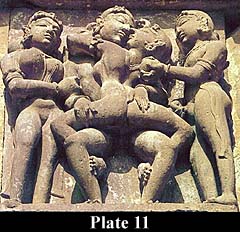 |
|
| ISSN 1084-7553 | |
| IJTS Vol. 2, No. 2 November 1996 |
|
| Editorial Note | |
| Setting the Stage | |
| The Artha of... | |
| Computer Space | |
| New Titles | |
| - Studi Orientali... | |
| - Autumn Leaves... | |
| - ChaNDI PATh... | |
| Support The IJTS |
|
|
|
|
| Search |
|
| Register |
|
| Create Your Profile | |
| Recover Password | |
| Log In |
|
| Institutional Sub |
|
| none | |
| by Michael Rabe |
|
The Artha of Temple KAma.
Thus, before examining four text-certifiable rationales for the plethora of sexual imagery at Khajuraho, I propose to clear away five other, less-credible alternatives. First, and notwithstanding the erudition of Alain Danielou, the variety of coital bandhas (clenches) or were not rendered in stone for sexual education of the general populace, newlyweds and kuNDalinI physiologists included.57 True, matches may be found, as between the straddling pose that tops the south antarAla of the VizvanAth [Plate 11] and prescriptions in sex manuals like the 12th century Ratirahasya,58 but divergences in matter, even between these relatively contemporary corpora, are far greater than their commonalties.59 [This is a preview of the full page; if you are a member of the Asiatica Association and have access to the IJTS, please login using the box on the left menu; non members: please become a member to support the Asiatica Association, and get full access to our publications.] |
|
©1995-2006 Asiatica Association. All Rights Reserved
site development L. Magnocavallo / site comments E. Garzilli |
 So there it is: lascivious iconography in abundance and integral to the conception and design of the NAgara order temples at Khajuraho. But still the perennial bafflement remains: whatever for? By what criteria and evidence
might genuine intentions of the architects, patrons and clergy of the Candella
court be isolated from the unwarranted inferences of later apologists, present
company not excluded? All one can really do is amass collateral documents of
the period and test their relevance against careful reading of the monuments
themselves according to one's own best lights at any given moment.
Fortunately, the challenge to present day scholars is more one of feast than
famine. A great wealth of potentially relevant documents have been identified,
by T.P. Bhattacharya and Devangana Desai among others, and their findings are
more than sufficient to start (or, rather, to continue) the winnowing
process.
So there it is: lascivious iconography in abundance and integral to the conception and design of the NAgara order temples at Khajuraho. But still the perennial bafflement remains: whatever for? By what criteria and evidence
might genuine intentions of the architects, patrons and clergy of the Candella
court be isolated from the unwarranted inferences of later apologists, present
company not excluded? All one can really do is amass collateral documents of
the period and test their relevance against careful reading of the monuments
themselves according to one's own best lights at any given moment.
Fortunately, the challenge to present day scholars is more one of feast than
famine. A great wealth of potentially relevant documents have been identified,
by T.P. Bhattacharya and Devangana Desai among others, and their findings are
more than sufficient to start (or, rather, to continue) the winnowing
process.